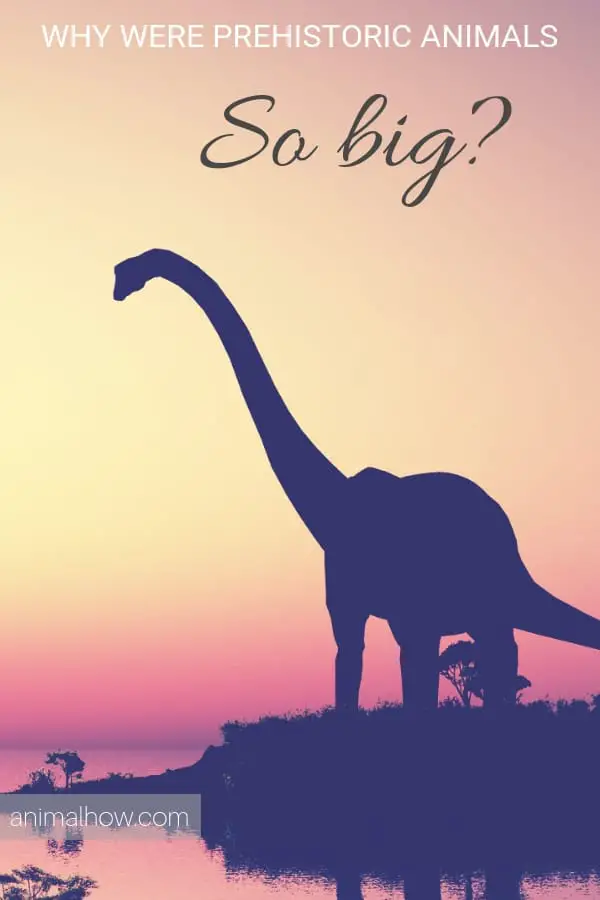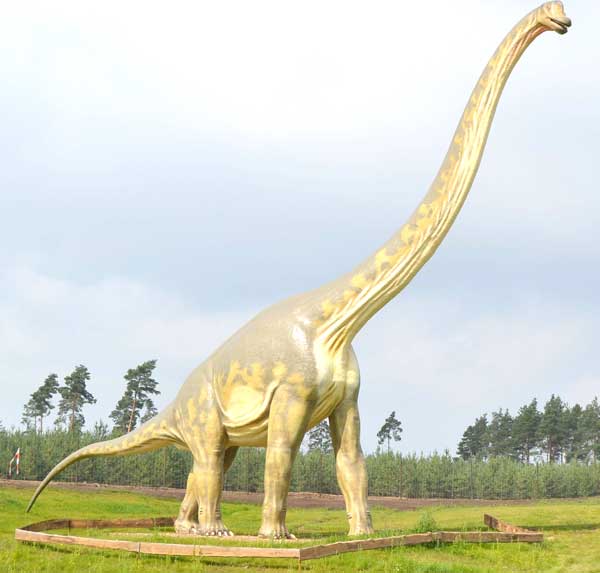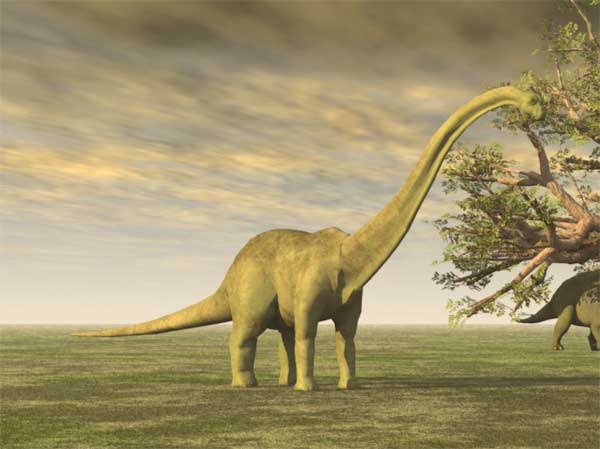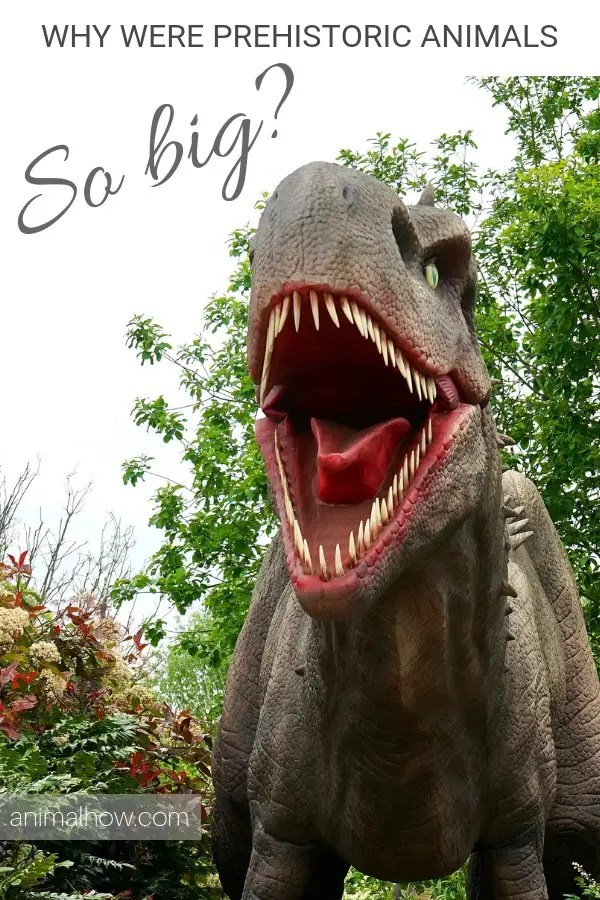We have all seen pictures of ancient dinosaurs and other prehistoric animals. One of the first things that come to mind is how incredibly HUGE they were. They seem to be a lot bigger than the animal we find today. But how come?
Why were prehistoric animals so big?
The dinosaurs had hollow bones filled with air that allowed them to breathe much more efficiently. We find the same bone structure today among birds. This also made the bones lighter so the animals wouldn’t collapse.
But there are many more theories and reasons why they became so big.
Let’s dig a bit deeper and look into the many AMAZING facts about these ancient monsters.
Table of Contents
Why Were Prehistoric Animals Bigger Than Today’s Animals?

During the Jurassic period, animals grew very much larger than the animals we have today.
Here are some common theories about why these animals were so huge:
1) Their bones were hollow
We have a lot of bones to examine from archaeological findings.
When you open up these bones you find it peculiar fact. They are in many cases hollowed out by air. This means that the bones are not as heavy as if they were solid.
In other words, if the bones were not hollowed out (and full of air) the animal would weigh significantly more. It may not have been able to function and walk at all.
So because of this fact, the dinosaurs were able to support a very long and tall body without the bone structure collapsing on the animal.
Most of the mammals we find on land today have solid bones. But when we look at birds we find the same bone structure. Many birds have what we call pneumatized bones.
The bones are not solid but they are filled with little backs of air. This gives a much lighter bone structure which enables the bird to fly.
The dinosaurs would also use the air inside the bones for breathing. That respiratory system would have them blow air into these little holes and the flow of air helped them get more effect out of each breath.
The largest plant-eating Sauropod weighed up to 80 tonnes. This is more than 12 times the weight of an African elephant. But now we are getting ahead of ourselves, we will get back to the Sauropods in a second.
2) They could live on less oxygen
Another cool fact from the time of the dinosaurs is that the oxygen levels in the air were lower.
So in order for the dinosaurs to survive, they developed a more efficient way of breathing.
As we just looked at it, the dinosaurs had a more effective way of breathing because they can utilize their little holes inside of their bones.

It is quite interesting that we find the same type of bones today in birds. This has led scientists to believe that the birds are actually ancestors of the old dinosaurs.
If you watch the birds fly higher over Mount Everest you might wonder how they can live in such thin air. If you put humans up there he/she wouldn’t survive for very long. So how come the birds can survive?
This is because they (just as the dinosaurs) developed a system that can utilize the oxygen in the air better.
Their respiratory systems are better than among humans and the big land animals we find today.
Over time, the levels of oxygen would rise and this gave the dinosaurs an advantage over the other animals. And maybe this fact helped them get as big as they became.
3) They could swallow branches without chewing them first
Dinosaurs were able to bite off big chunks of branches and swallow them whole. We know this from studying their skulls.
Because they could do so they didn’t need teeth. This again means that the heads were lighter and the long neck was able to support the head.
Otherwise, the long necks wouldn’t have been able to support the head.
This also means that the huge dinosaurs were able to eat much more food. When you don’t have to chew the food you can obviously eat much faster. This is another fact that enabled the dinosaurs to eat enough food during the day in order to get these big bodies going.
4) They had a long time to evolve
This is yet another theory. According to what is often called Cope’s Rule, an animal will get a lot larger and larger over time.
This is something scientists believed for a long time but today we have also found signs that point towards animals becoming smaller over time.
So even though it sounds possible this might not be the right theory. Nonetheless, it is still a theory and the facts are that we do not have much knowledge about what really happened to the dinosaurs or why they became so big.

5) They had plenty of food
During the time of the dinosaurs, the CO2 levels in the atmosphere were higher than we find today. This also means that plants and trees grow higher and bigger.
So in order to eat from the trees leaves the animals had to grow taller.
It also means they had plenty of food to eat because that were more and bigger trees. A much bigger percentage of the earth was covered with forest.
So if you combine these two facts, the dinosaurs had very good conditions for growing as big as they did.
6) They had few enemies
When you are 98 feet long (30 meters) you don’t have any natural enemies.
When you get big enough no one can hurt you. This is also true in the animal kingdom. The dinosaurs had no natural enemies which mean they could go and sleep where they wanted.
Lions, Tigers, and other predators will always try to hunt animals that are smaller or at least the same size as themselves.
This doesn’t necessarily explain how they became so big that it was definitely an advantage that kept them at the top of the food chain for many years during that period.
Why Are African Animals So Big?
The biggest mammal we find today is the African Elephant. It can weigh up to 5 tons.
Why did it grow so big, and why are the Giraffes so big as well? Let’s take a closer look.
Making the best way to answer this question is to turn the question on the head. Let’s instead ask why there aren’t any giant animals left in North America. And now the answer becomes not obvious.
This is probably due to two factors:
- Climate change
The climate changes all the time. It seems there have been better conditions for the big land mammals around Africa - Hunting
It has always been associated with manliness to hunt big animals. This could be the reason why all the biggest animals have been hunted down and we don’t see any megafauna around North America anymore.
The first people to walk the earth probably lived around the African continent.
This could also mean that giant animals and people coexisted there for many years.
Maybe the first explorer generations were more prone to go hunting after the big animals in order to survive. But that’s just my own theory.
What Is The Biggest Animal Of All Time?
Let’s start with the biggest plant-eating animals that ever lived.
These were the amazing and majestic Sauropods.

They could weigh up to 80 tons and they were probably the biggest animal that ever walked the earth.
The Brontosaurus was part of the Sauropod family:

The biggest sea animal, however, is still around today. Here we are talking about the Blue Whale.
The amazing blue whale is definitely the king of the ocean.
It can be up to 98 feet long (30 meters) and it is still to this day the biggest animal that has ever lived.

It is more than doubled the size of the Sauropod. The blue whale can weigh up to 190 short tons (170 tons). You can read more here about the amazing blue whale.
It’s quite interesting that the biggest animal that ever lived on the earth still around. So where can you go to see the amazing Blue Whale? You have to travel to the Arctic Tundra. The Blue Whale lives around the Arctic area along with a list of other tough and very special Arctic animals.
Share Us On Pinterest
Liked the article? Share us on Pinterest <3

Sources: Berkeley.edu, net.au, theguiardian.com





